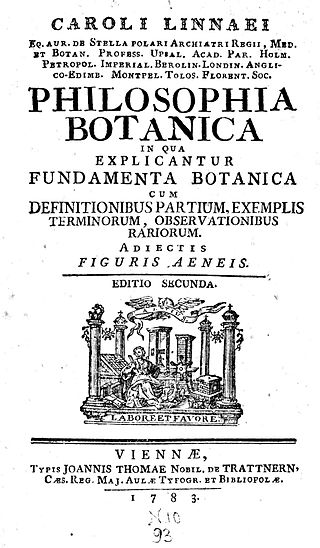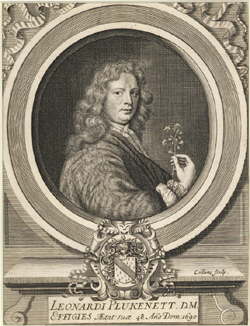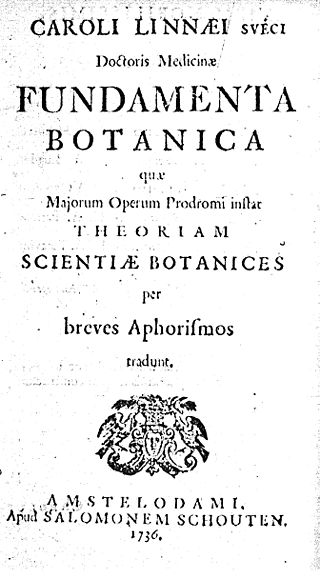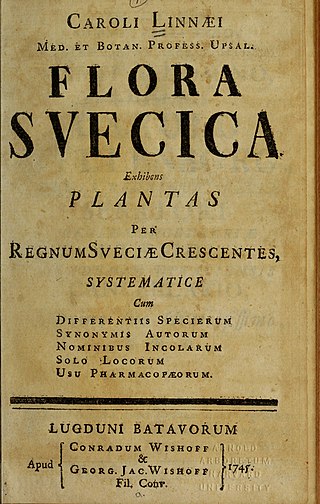
Carl Linnaeus, also known after ennoblement in 1761 as Carl von Linné, was a Swedish biologist and physician who formalised binomial nomenclature, the modern system of naming organisms. He is known as the "father of modern taxonomy". Many of his writings were in Latin; his name is rendered in Latin as Carolus Linnæus and, after his 1761 ennoblement, as Carolus a Linné.

Systema Naturae is one of the major works of the Swedish botanist, zoologist and physician Carl Linnaeus (1707–1778) and introduced the Linnaean taxonomy. Although the system, now known as binomial nomenclature, was partially developed by the Bauhin brothers, Gaspard and Johann, Linnaeus was first to use it consistently throughout his book. The first edition was published in 1735. The full title of the 10th edition (1758), which was the most important one, was Systema naturæ per regna tria naturæ, secundum classes, ordines, genera, species, cum characteribus, differentiis, synonymis, locis, which appeared in English in 1806 with the title: "A General System of Nature, Through the Three Grand Kingdoms of Animals, Vegetables, and Minerals, Systematically Divided Into their Several Classes, Orders, Genera, Species, and Varieties, with their Habitations, Manners, Economy, Structure and Pecularities".

Antonio José Cavanilles was a leading Spanish taxonomic botanist, artist and one of the most important figures in the 18th century period of Enlightenment in Spain.

Nathanael Matthaeus von Wolf, Nathanael Matthäus von Wolf, Polish: Nataniel Mateusz Wolf was a German botanist, physician, and astronomer.
Karl Julius Perleb was a German botanist and natural scientist.

Philosophia Botanica was published by the Swedish naturalist and physician Carl Linnaeus (1707–1778) who greatly influenced the development of botanical taxonomy and systematics in the 18th and 19th centuries. It is "the first textbook of descriptive systematic botany and botanical Latin". It also contains Linnaeus's first published description of his binomial nomenclature.

Count Friedrich Carl Eugen Vsemir von Berchtold, baron von Ungarschitz, was a German-speaking Bohemian physician and botanist from Austrian descent.

Leonard Plukenet (1641–1706) was an English botanist, Royal Professor of Botany and gardener to Queen Mary.
Johannes Conrad Schauer was a botanist interested in spermatophytes. He was born in Frankfurt am Main and attended the gymnasium of Mainz from 1825 to 1837. For the next three years he worked at the Hofgarten of Würzburg. Schauer then gained a position as assistant at the botanical garden at Bonn where he worked until 1832 when he was placed in charge of the botanic garden in Breslau, with C.G. Nees. He gained the degree of Doctor of Philosophy at the University of Erlangen-Nuremberg 1835 and was appointed professor of botany at the University of Greifswald from 1843 until his death in 1848.

Johannes Browallius, also called John Browall, was a Finnish and Swedish Lutheran theologian, physicist, botanist and at one time friend of Swedish taxonomist Carl Linnaeus.
Frans Antonie Stafleu was a Dutch systematic botanist, former Chair of the Institute of Systematic Botany at the University of Utrecht, and author of Taxonomic Literature: A Selective Guide to Botanical Publications and Collections, with Dates, Commentaries, and Types along with 644 other publications. He occupied several positions in the International Association for Plant Taxonomy. The latter organization now triennially awards the Stafleu Medal "for an excellent publication dealing with historical, bibliographic and/or nomenclatural aspects of plant systematics".

Genera Plantarum is a publication of Swedish naturalist Carl Linnaeus (1707–1778). The first edition was issued in Leiden, 1737. The fifth edition served as a complementary volume to Species Plantarum (1753). Article 13 of the International Code of Nomenclature for algae, fungi, and plants states that "Generic names that appear in Linnaeus' Species Plantarum ed. 1 (1753) and ed. 2 (1762–63) are associated with the first subsequent description given under those names in Linnaeus' Genera Plantarum ed. 5 (1754) and ed. 6 (1764)." This defines the starting point for nomenclature of most groups of plants.

The bibliography of Carl Linnaeus includes academic works about botany, zoology, nomenclature and taxonomy written by the Swedish botanist Carl Linnaeus (1707–1778). Linnaeus laid the foundations for the modern scheme of binomial nomenclature and is known as the father of modern taxonomy. His most famous works are Systema Naturae which is considered as the starting point for zoological nomenclature together with Species Plantarum which is internationally accepted as the beginning of modern botanical nomenclature.

Critica Botanica was written by Swedish botanist, physician, zoologist and naturalist Carl Linnaeus (1707–1778). The book was published in Germany when Linnaeus was 29 with a discursus by the botanist Johannes Browallius (1707–1755), bishop of Åbo. The first edition was published in July 1737 under the full title Critica botanica in qua nomina plantarum generica, specifica & variantia examini subjiciuntur, selectoria confirmantur, indigna rejiciuntur; simulque doctrina circa denominationem plantarum traditur. Seu Fundamentorum botanicorum pars IV Accedit Johannis Browallii De necessitate historiae naturalis discursus.

Fundamenta Botanica was one of the major works of the Swedish botanist, zoologist and physician Carl Linnaeus (1707–1778) and issued both as a separate work and as part of the Bibliotheca Botanica.

Flora Svecica was written by Swedish botanist, physician, zoologist and naturalist Carl Linnaeus (1707–1778).

Bibliotheca Botanica is a botany book by Swedish naturalist Carl Linnaeus (1707–1778). The book was written and published in Amsterdam when Linnaeus was twenty-eight and dedicated to the botanist Johannes Burman (1707–1779). The first edition appeared in 1736 with the full title Bibliotheca Botanica recensens libros plus mille de plantis huc usque editos secundum systema auctorum naturale in classes, ordines, genera et species; it was an elaborate classification system for his catalogue of books.
Robert Everard Woodson was an American botanist. He received a degree in biology in 1929 at Washington University in St. Louis, Missouri.
Erik Albert Mennega was a Dutch botanist, plant taxonomist, and author.
















